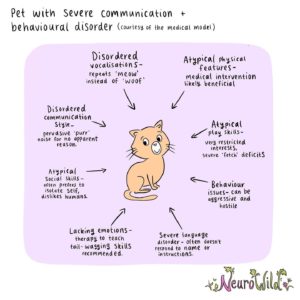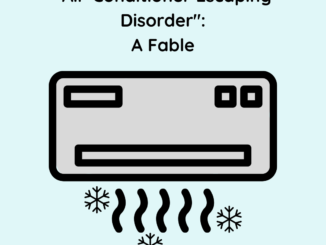This post by NeuroWild does an incredibly concise job of showing the harm that the “medical model” can perpetuate in describing autism — specifically, in the way that it describes Autistic people solely by comparing them to non-Autistic people and then calling those things deficits or dysfunction, instead of by recognising and describing the unique ways in which Autistic people show those traits or engage in those things in their own way.

[Image description: A small cartoon drawn orange cat sits in the middle of a faded purple square surrounding it. The title of the cartoon is “Pet with severe communication + behavioural disorder (courtesy of the medical model).” Then there are a number of arrows pointing to the cat with various labels:
“Disordered vocalisations – repeats ‘meow’ instead of ‘woof’
Atypical physical features – medical intervention likely beneficial
Atypical play skills – very restricted interests, severe ‘fetch’ deficits
Behaviour issues- can be aggressive and hostile
Severe language disorder – often doesn’t respond to name or instructions.
Lacking emotions – therapy to teach tail-wagging skills recommended
Atypical social skills – often prefers to isolate self, dislikes humans.
Disordered communication style – pervasive ‘purr’ noise for no apparent reason.”
The cat looks happy and content, because it’s happy to be a cat.
The @NeuroWild logo, pink and yellow hand-drawn letters with leaves and flowers sprouting from them, is in the bottom right corner.
End description.]
“This dysfunctional dog does not know how to woof!” says an arrow, pointing toward a cat.
“This person is unable to communicate and must be drilled on single-word ‘requesting’ speech until they’ve learned how to make their needs met!”, say a lot of speech therapists, pointing toward a child who might actually thrive using sign language, an app for speaking on a tablet, or who might even be speaking with their voice but doing so with long, intonation-rich sounds that sound like language but aren’t quite English words yet, because they are a Gestalt language learner and that is the first stage of their natural language development.
“This dysfunctional dog does not know how to play fetch!” says an arrow pointing toward a cat.
“This child doesn’t have any play skills and must be taught how to pretend with dolls or throw a ball back and forth,” say a lot of therapists (even OTs), pointing toward a child who is deeply and joyfully immersed in sensory-rich play, or repeating the same play schema over and over because of how much pleasure and joy it brings them, or because they are a young scientist who is closely and with fascination observing how tiny differences in what they do cause the effect to change.
“This dysfunctional dog doesn’t show emotions because their tail doesn’t wag,” says an arrow pointing toward a cat.
“This person has no empathy for others and has to be taught,” say a lot of therapists (even OTs), pointing toward a person who might not have the internal language to make sense of their own feelings and internal sensations yet (let alone other people’s), or who might feel overwhelming and intense empathy so strong that it pushes them into meltdown or shutdown, or who might be expressing empathy in ways that aren’t being acknowledged, like by trying to make the other person laugh or by trying to tell a story to relate to them.
Because it’s a cat. It’s not a dog. It’s a cat. It’s great at being a cat. It has cat skills. It expresses them in cat ways. It might need help with cat problems, but the problems are things happening to the cat. The problems aren’t the literal fact that it’s a cat.



